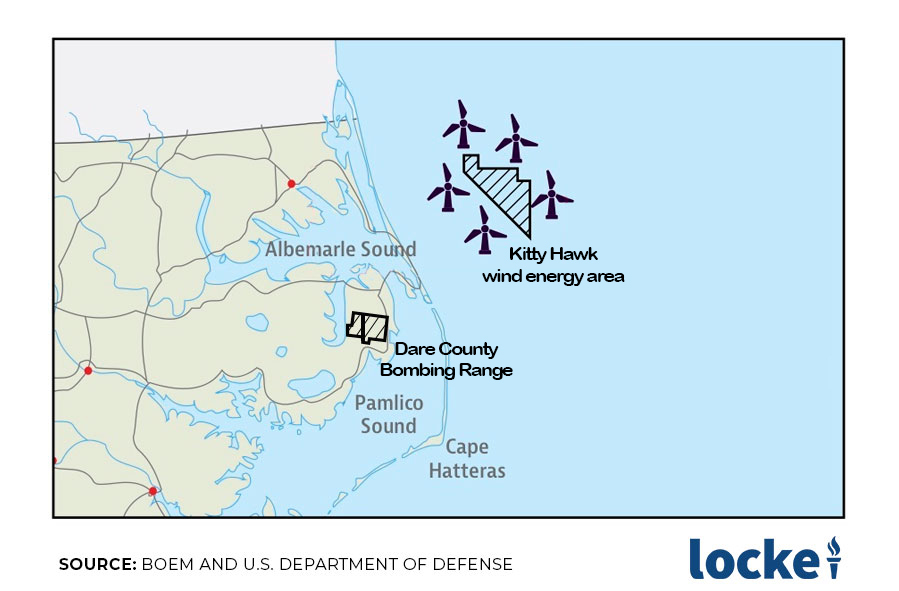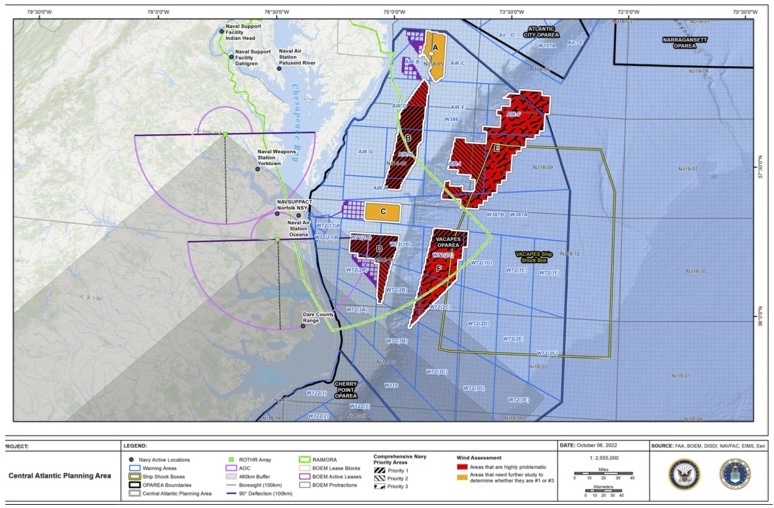Publisher's Note: This post appears here courtesy of the
John Locke Foundation. The author of this post is
Jon Sanders.
- The Pentagon alerted the Biden administration that several offshore wind energy areas slated for development would severely conflict with military operations, facilities, and training
- Among the worst ones highlighted is the Kitty Hawk wind energy area, being developed off the Outer Banks
- Concerning the Kitty Hawk project and a few others, the Pentagon "would be unable to continue its mission as currently conducted in the space"
Does Pres. Joe Biden want to compromise national security in order to rush a political goal for offshore wind energy? In his first week in office, Biden set a goal of
"doubling offshore wind by 2030." Shortly afterward he announced
"rapid offshore wind deployment" - with
"ambitious wind energy projects" and
"bold actions" to
"catalyze offshore wind energy" going
"up and down the Atlantic Coast."
All of those phrases show what a frenzied hurry the president is in - and furthermore indicate little interest in his administration taking a measured approach given so many unstudied yet deeply impactful issues involved:
- How expensive offshore wind is
- What impacts it will have on ratepayers and energy poverty
- Why it cannot yield any measurable or palpable difference in climate change
- What impacts it will have on critically endangered, threatened, and other marine animals and avian species
- What effects it will have on job creation and economic growth
- What effects it will have on beach tourism
- What impacts it will have on the coastal fishing industry
- How well the enormous turbines could hold up in North Carolina's uniquely hurricane-prone waters
- How we will dispose of "forever waste" from blades
Recently, the Pentagon has alerted the Biden administration of another critically unstudied matter: that several offshore wind areas planned for development would cause serious problems for U.S. military operations, facilities, and training. Among the worst is the Kitty Hawk wind energy area, being developed off the coast of North Carolina by Iberdrola through Avangrid Renewables.
The Kitty Hawk offshore wind project would span an area of approximately 193 square miles (50,000 hectares) to produce 3.5 gigawatts (GW) of intermittent, weather-dependent electricity. This enormous area - over twice the area of the city of Norfolk, Virginia - would contain 69 wind turbines reaching 1,042 feet (317.5 meters) from base to tip. They would immediately become the tallest manmade structures in North Carolina by far. They would be about 20 percent taller than the state's tallest building, the Bank of America Corporate Center in Charlotte. The project would be situated 24 nautical miles off the Outer Banks.

This huge city of massive, whirling skyscrapers would create significant obstacles to military operations and be especially disruptive of fighter jet training using the Dare County Bombing Range, a training range covering
"a total area of 46,621 acres and contains two separate and independent weapon impact areas." According to the U.S. Air Force, the Dare County Bombing Range meets
"F-15E training requirements of not only the 4th Fighter Wing at Seymour Johnson Air Force Base, N.C., but also the Navy and Marine Corps."
Proximity of the Kitty Hawk Wind Energy Area to the Dare County Bombing Range Used by the 4th Fighter Wing at Seymour Johnson Air Force Base and the Navy and Marine Corps
 "Highly Problematic"
"Highly Problematic": Map of wind energy areas off the coasts of North Carolina, Virginia, Maryland, and Delaware flagged as
"highly problematic" by the Navy and Air Force

As first reported by Bloomberg on April 17,
The Pentagon is sounding alarms over Biden administration plans to advance offshore windprojects along the central Atlantic US coast, warning that almost all of the new terrain eyed for development conflicts with military operations.
Maps shared with industry stakeholders and seen by Bloomberg News show vast red areas that the Navy and Air Force have deemed "highly problematic," covering prime real estate the Interior Department last year earmarked for leasing off the coasts of North Carolina, Virginia, Maryland and Delaware. ...
The Pentagon has identified challenges operating around wind turbines that would be installed into the seabed in Atlantic waters near many of its operations and facilities, including North Carolina's Dare County bombing range, used for training fighter jet crews, and a weapons station in Yorktown, Virginia. They are documented vividly on a map of Navy and Air Force concerns, dated Oct. 6, 2022, and circulated with industry and state stakeholders this month.
The map shows a concentration of six offshore wind projects in coastal Atlantic waters highlighted as problematic by the Pentagon. Four of the six areas, including the Kitty Hawk project, were highlighted in red, signifying areas the Pentagon considered
"highest priority" areas. It is in these areas, including the Kitty Hawk project,
"the Pentagon would be unable to continue its mission as currently conducted in the space."
Upcoming research briefs will discuss still more military, national defense, and shipping safety dangers posed by enormous areas full of massive wind turbines.



